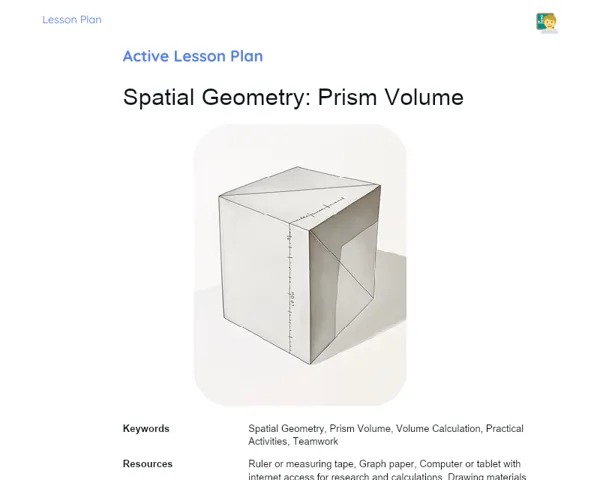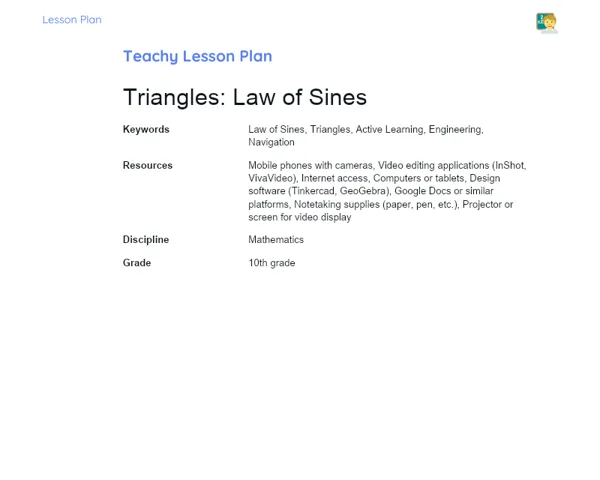Lesson Plan | Socioemotional Learning | Spatial Geometry: Volume of the Cylinder
| Keywords | Spatial Geometry, Cylinder Volume, Mathematics, High School, Self-awareness, Self-control, Responsible Decision-Making, Social Skills, Social Awareness, RULER, Guided Meditation, Practical Activity, Emotional Reflection, Personal Goals |
| Resources | Cylindrical containers (soda cans, bottles, jars), Ruler, Tape measure, Calculator, Paper and pen for notes, Calm environment for meditation, Reflection cards |
| Codes | - |
| Grade | 11th grade |
| Discipline | Mathematics |
Objective
Duration: 10 to 15 minutes
This part of the Socioemotional Lesson Plan is designed to introduce students to the concept of the volume of a cylinder and equip them with the skills necessary to calculate volumes in real-world scenarios. We aim for students to grasp not just the theoretical aspects of the formula but also how to apply it to everyday situations, enriching their learning experience meaningfully.
Objective Utama
1. Explain the formula for calculating the volume of a cylinder (base area times height).
2. Apply the cylinder volume formula to solve practical problems, such as finding the volume of cylindrical containers.
Introduction
Duration: 15 to 20 minutes
Emotional Warmup Activity
Guided Meditation for Focus and Concentration
The chosen emotional warm-up activity is Guided Meditation. This practice involves directing students' focus to the present moment, helping them attain a state of calmness and concentration. Guided meditation aids in alleviating anxiety, enhancing concentration, and fostering a more balanced classroom of learning.
1. Preparation: Ask students to sit comfortably in their chairs with their backs straight and feet flat on the floor. They can either close their eyes or focus on a stationary point in the room.
2. Initial Breathing: Instruct students to start with a few deep breaths. Inhale through the nose for a count of four, hold the breath for four seconds, and slowly exhale through the mouth for a count of six.
3. Guiding the Meditation: Using a calm and soft voice, guide students to envision a peaceful setting, like a quiet beach or a field of flowers. Describe the environment in detail, encouraging them to imagine the colors, sounds, and fragrances of this setting.
4. Body Focus: Encourage students to shift their attention to various parts of their bodies, starting from their feet and gradually moving up to their heads. Ask them to relax each body part as they go along.
5. Finalization: Gently bring students back to the present. Ask them to become aware of their surroundings by slowly wiggling their fingers and toes. Instruct them to open their eyes whenever they feel prepared.
6. Reflection: Invite students to share how they felt during the meditation and whether they noticed any changes in their concentration and calm.
Content Contextualization
Spatial geometry, especially the calculation of cylindrical volumes, appears in various facets of our daily lives. For instance, when estimating the capacity of containers like soda cans, water tanks, and even in architectural designs, knowing how to calculate volumes is crucial. Additionally, recognizing these practical applications can enhance students' motivation and develop socioemotional skills, such as responsible decision-making and social awareness. By tackling real-life problems and appreciating the significance of mathematical knowledge in the world, students are likely to feel more connected and prepared for challenges ahead.
Development
Duration: 60 to 75 minutes
Theory Guide
Duration: 20 to 25 minutes
1. Definition of Cylinder: Explain that a cylinder is a geometric shape with two parallel circular bases and a curved lateral surface connecting them.
2. Components of the Cylinder:
3. Base: The two parallel circular surfaces.
4. Height (h): The vertical distance between the two bases.
5. Radius (r): The distance from the center of the base to any point on its edge.
6. Volume Formula: Introduce the volume formula for a cylinder: V = πr²h, where V is the volume, r is the radius of the base, and h is the height of the cylinder.
7. Practical Example: If a cylinder has a height of 10 cm and a base radius of 3 cm, the volume calculation goes as follows:
8. First, calculate the base area: A = πr² = π(3 cm)² = 9π cm².
9. Next, multiply the base area by the height: V = A * h = 9π cm² * 10 cm = 90π cm³.
10. Analogies to Facilitate Understanding:
11. Relate the cylinder to a soda can to help students visualize its shape and parts.
12. Use the concept of stacking coins (which are circular) to illustrate how the height of the cylinder is formed.
Activity with Socioemotional Feedback
Duration: 35 to 40 minutes
Calculating the Volume of a Cylindrical Container
In this hands-on activity, students will calculate the volume of various cylindrical containers like soda cans, bottles, and jars. They will work in groups to measure the containers, apply the volume formula, and discuss how these calculations can be useful in their daily lives.
1. Group Formation: Divide the class into groups of 3 to 4 students.
2. Distribution of Materials: Provide each group with assorted cylindrical containers and measuring tools (like rulers, tape measures, etc.).
3. Measure the Containers: Ask students to measure the base radius and height of each container.
4. Calculate the Volume: Instruct students to apply the formula V = πr²h to find the volume of each container.
5. Group Discussion: After the calculations, students should discuss the differences in the volumes they got and reflect on how these insights can be applied in real-life scenarios.
6. Recording the Results: Ask students to jot down their findings and reflections on a sheet of paper to share with the class.
Discussion and Group Feedback
🌟 Group Discussion and Socioemotional Feedback: To implement the RULER method, begin by recognizing the emotions that surfaced during the activity. Ask students how they felt while collaborating and calculating volumes. This fosters the acknowledgment of feelings like excitement, frustration, or satisfaction, nurturing Self-awareness.
💬 Understanding and Naming Emotions: Encourage students to think about what caused these emotions and articulate them. For example, realizing that frustration might stem from challenges in measuring or calculating can enhance Understanding and Naming emotions.
🗣️ Expressing and Regulating Emotions: Motivate students to convey their emotions constructively during the discussion to cultivate a respectful classroom environment and promote Social Awareness. Discuss strategies to regulate emotions like frustration, such as seeking assistance or sharing tasks, which encourage Self-control and Responsible Decision-Making.
Conclusion
Duration: 15 to 20 minutes
Reflection and Emotional Regulation
📜 Reflection and Emotional Regulation Activity: To wrap up the lesson, ask students to write a reflection or engage in a discussion about the challenges they encountered during the lesson and how they managed their emotions. They can pen down a paragraph or verbally share their experiences, emphasizing moments of frustration, satisfaction, or teamwork. Encourage them to contemplate strategies they adopted to overcome difficulties and how these can be employed in other academic and personal contexts.
Objective: 🎯 Objective of Reflection and Emotional Regulation: This activity's purpose is to stimulate self-assessment and emotional management. By reflecting on the hurdles faced and how they coped with their emotions, students will identify effective strategies to tackle challenging situations. This not only bolsters self-awareness and self-control but also fosters responsible decision-making and social skills as they listen to and share each other's experiences.
Glimpse into the Future
📅 Closing Activity and Looking to the Future: To conclude the lesson, ask students to establish personal and academic goals linked to the topics covered. Goals may include practicing more problems in spatial geometry, assisting classmates who are struggling with the subject, or applying their learning in personal projects, like calculating volumes in daily life. Encourage them to write these goals in their notebooks and review them frequently.
Penetapan Objective:
1. Practice more exercises in spatial geometry.
2. Support peers who are having difficulty with the topic.
3. Utilize knowledge in personal projects, such as calculating volumes in everyday tasks.
4. Reinforce and consolidate understanding of the concepts of cylinder volume.
5. Engage actively in lessons by asking questions and contributing examples from real life. Objective: 🎯 Objective of the Closing and Looking to the Future: This section aims to reinforce students' independence and the practical application of learning. By setting personal and academic goals, students are motivated to continue honing their mathematical and socioemotional skills. This promotes ongoing, meaningful learning, preparing them to confront future challenges with more confidence and competence.


